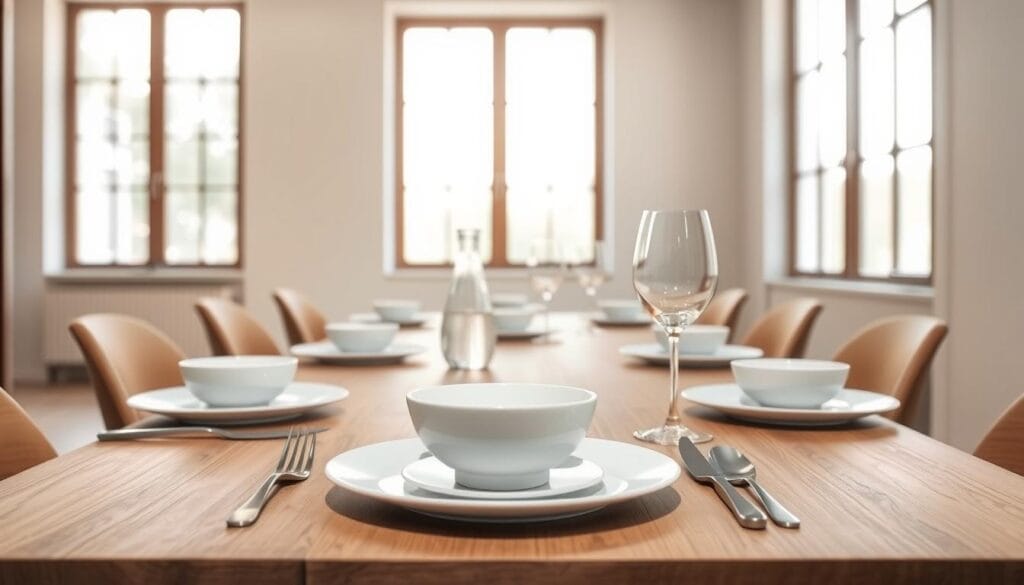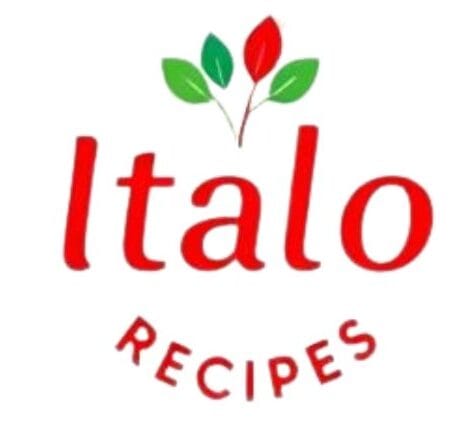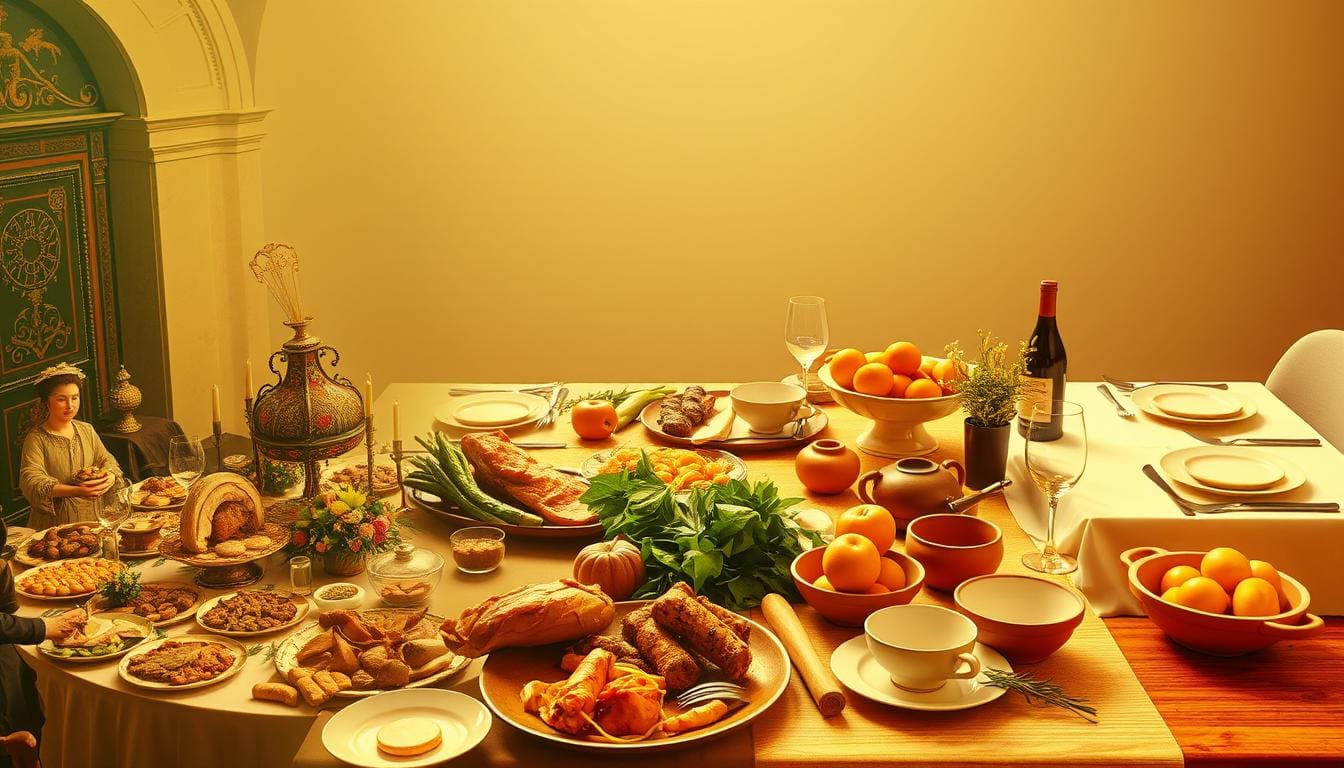Dal Banchetto alla Tavola Moderna 2025:Come è Cambiata la Tavola Italiana,Viaggio nel Tempo
Dal Banchetto alla Tavola Moderna 2025:Have you ever enjoyed the delicious tastes of Italian cuisine in a cozy trattoria or at home? Wondered how this tradition evolved?
The tale of Italian dining is a captivating story. It’s shaped by centuries of cultural changes, societal shifts, and important events. These have all changed how Italians enjoy meals.
As you delve into the history of Italian cuisine, you’ll see how it has grown. It has moved from the grandeur of ancient feasts to the simplicity of today’s tables.
Table of Contents
Key Takeaways
- The evolution of Italian dining reflects the country’s rich history and cultural heritage.
- Societal shifts and key events have significantly influenced Italian cuisine.
- Modern Italian dining is characterized by a blend of traditional and contemporary elements.
- The culinary evolution has transformed Italian cuisine into a global phenomenon.
- Understanding the history of Italian dining enhances appreciation for its cultural significance.
The Ancient Roots of Italian Dining Culture
The history of Italian dining is deeply rooted in the country’s ancient past. The Etruscan and Roman civilizations set the stage for Italy’s rich food culture. Their traditions have shaped the way Italians enjoy meals today.
Etruscan and Roman Banquet Traditions
The Etruscan and Roman banquets were key in forming Italian dining culture. The Romans, especially, were famous for their grand feasts. These feasts featured the triclinium, where guests reclined on three sides of a table.
Social Hierarchy at the Roman Table
At Roman banquets, social status was clear. The most honored guests sat in the center. Others were seated based on their rank. This setup influenced dining layouts and mealtime interactions.
| Feature | Etruscan Banquets | Roman Banquets |
|---|---|---|
| Dining Arrangement | Reclining on couches | Triclinium with three-sided reclining |
| Social Aspect | Elite gatherings | Reflected social hierarchy |
| Culinary Focus | Exotic spices and flavors | Variety of dishes, including coena and secundae mensae |
These ancient traditions still influence Italian dining today. They shape everything from dining room layouts to mealtime etiquette. Exploring Italian cuisine’s history reveals how these early traditions continue to define Italy’s food culture.
Medieval Feasts: Symbolism and Spectacle
Exploring Italian dining history, you’ll see how medieval feasts shaped the country’s food culture. These events were more than just meals; they were grand displays of wealth and status.
Monastery Influence on Italian Cuisine
Monasteries greatly influenced Italian food during the medieval times. Monks kept and improved recipes, creating a deep culinary heritage. They grew gardens, raised animals, and tried new dishes, starting many Italian food traditions.
Noble Banquets as Displays of Power
Noble banquets were grand shows of power and wealth. The nobility spent a lot on these feasts, using exotic spices, rare meats, and fancy presentations. These events were key for making alliances, showing status, and being hospitable.
Common People’s Dining Habits in Medieval Italy
On the other hand, common people ate simply with what was locally available. They mostly had bread, vegetables, and legumes, with meat being a rare treat. Yet, their meals were often tasty and full of nutrition, showing the creativity of medieval cooks.
Renaissance Revolution: Dal Banchetto alla Tavola Moderna Begins
The Renaissance in Italy sparked a culinary revolution. It refined dining practices and set the stage for modern Italian cuisine. This era saw significant cultural and artistic growth, which changed how people dined.
Caterina de’ Medici and the Refinement of Italian Gastronomy
Caterina de’ Medici was a key figure in shaping Italian cuisine. Her influence went beyond royal courts, bringing refined dining to the masses. She brought a love for fine food from Florence, enhancing dining in France and Italy.
She introduced forks to Italian dining, making meals less messy. Before, people ate with their hands or simple tools.
Bartolomeo Scappi and the First Modern Cookbooks
The Renaissance also marked the start of modern cookbooks. Bartolomeo Scappi, a famous chef, wrote Opera, a detailed cookbook. It standardized Italian dishes and became a guide for future chefs.
« Scappi’s Opera was a culinary bible for the Renaissance kitchen, offering a glimpse into the sophisticated dining practices of the time. »
Table Settings and Dining Etiquette Innovations
The Renaissance also introduced new table settings and dining rules. Fine linens, delicate glassware, and fancy tableware became common. Dining etiquette evolved, with rules for using utensils and polite conversation.
| Dining Element | Pre-Renaissance | Post-Renaissance |
|---|---|---|
| Utensils | Crude, often shared | Personalized, refined (e.g., forks) |
| Tableware | Simple, functional | Intricately designed, fine materials |
| Etiquette | Informal, often messy | Formalized rules, polite conversation |
Baroque Splendor and Regional Diversity
In the 17th century, Italian food showed the Baroque love for drama. This time was full of new tastes and different flavors from all over Italy.
Theatrical Food Presentations of the 17th Century
The 17th century was all about theatrical food presentations. Chefs turned into artists, making dishes that amazed the eyes and taste buds. These fancy displays were a big part of the Baroque era’s impact on Italian food.
- Intricate designs made from sugar and food coloring
- Use of exotic spices and rare ingredients
- Multi-tiered serving dishes and ornate table settings
The North-South Divide in Culinary Traditions
Italian food started to show a clear North-South divide. The North was influenced by European foods, with lots of butter and meat. The South kept its Mediterranean diet, full of olive oil, veggies, and seafood.
- Northern Italy’s dishes were rich and hearty
- Southern Italy focused on fresh, local ingredients
Foreign Influences on Italian Noble Tables
Italian noble tables were also affected by foreign influences. The 17th century brought new ingredients and cooking methods from around the world. This was thanks to more trade and cultural sharing.
Some big foreign influences were:
- Spices and chilies from the New World
- Cooking techniques from France and Spain
From Unification to Industrialization: 19th Century Transformations
In the 19th century, Italy’s unity changed its food scene a lot. This time saw big changes in how people ate, thanks to the country’s new unity and industrial growth.
Pellegrino Artusi and the Codification of Italian Cuisine
Pellegrino Artusi was key in making Italian food standard. His book, « La Scienza in Cucina e l’Arte di Mangier Bene, » came out in 1891. It mixed recipes from all over Italy, creating a single Italian food identity.
Artusi’s work helped codify Italian cuisine. It made Italian food known to more people. This set the stage for today’s Italian cooking.
The Rise of Caffè Culture and Public Dining
The 19th century also brought a boom in caffè culture and public dining. Places like Florence, Rome, and Venice became famous for their fancy cafes. Here, people could enjoy coffee, pastries, and light meals.
This new scene showed how Italian lifestyles were changing, especially in cities. It helped grow a lively food culture.
Rural vs. Urban Dining Practices
The 19th century showed a big difference between city and country food ways in Italy. Cities adopted new, world-inspired eating habits. But, rural areas stuck to old ways and local foods.
This difference made Italian food very diverse. Each area developed its own special dishes.
Early 20th Century: Tradition Meets Modernity
The early 20th century was a time of big change in Italian dining. It was a mix of old traditions and new ideas, shaping Italy’s food culture.

Futurist Cuisine and Culinary Avant-Garde
The Futurist movement, led by Filippo Tommaso Marinetti, changed Italian food. Futurist cuisine was all about new and bold ideas. Chefs tried out strange flavors and ways to present food, making it a true art form.
Impact of World Wars on Italian Food Habits
The World Wars changed how Italians ate. Food was scarce, so people had to get creative. This led to a focus on simple, resourceful cooking that’s still seen today.
The Birth of Modern Italian Restaurant Culture
In the early 20th century, modern Italian restaurant culture started to grow. Restaurants began to serve a wider range of people, offering better food. This helped create Italy’s lively restaurant scene we know today.
The mix of old and new in early 20th-century Italy set the stage for today’s food. As you learn more about Italian dining, you’ll see how these early steps led to the cuisine we love now.
Post-War Revolution: The Democratization of Italian Dining
After World War II, Italian food became more common and varied. The country’s economy grew fast, turning it into an industrial powerhouse. This change deeply affected how people ate.
Economic Miracle and Changing Family Meals
The 1950s and 1960s were prosperous for many Italian families. Meals became more varied and enjoyable. People could afford better ingredients, making meals more relaxed.
- Increased consumption of meat and dairy products
- Greater variety in daily meals
- More emphasis on leisurely dining experiences
Italian Cuisine Goes Global
Italy’s growing economy spread its influence, including its food. Italian restaurants popped up worldwide, introducing new flavors. You could find authentic Italian dishes in cities like New York and Tokyo.
- Italian migration to other countries, bringing culinary traditions with them
- Increased international travel, allowing people to experience Italian cuisine firsthand
- Globalization of food culture through media and culinary exchange programs
New Appliances and Their Impact on Home Cooking
New kitchen gadgets emerged after the war, changing cooking at home. Electric refrigerators, mixers, and other tools made cooking easier. These appliances included:
- Electric refrigerators, allowing for better food storage
- Microwave ovens, enabling quick reheating and cooking
- Food processors, simplifying meal preparation
These advancements made Italian dining more accessible and enjoyable for everyone.
Modern Italian Table: 1990s-2010s
The 1990s to the 2010s saw big changes in Italian dining. This time focused on keeping culinary traditions alive. New influences also changed how Italians enjoyed meals.
Slow Food Movement and Culinary Heritage Preservation
The Slow Food movement started in 1989 and grew in the 1990s. It highlighted the need to save culinary heritage and support local food. This movement helped Italians value traditional dishes and local farmers.
Slow Food focused on local specialties and old cooking ways. This sparked a new interest in local foods and family recipes.
The Celebrity Chef Phenomenon in Italy
In the 1990s and 2000s, celebrity chefs became big in Italy. Chefs like Gualtiero Marchesi and Gianfranco Vissani were famous. They brought new cooking styles and shared Italian food with the world.
Digital Age Influences on Food Culture
The digital age changed Italian food culture a lot. Social media, blogs, and online recipes made finding new food ideas easy. This digital shift opened up a world of culinary exploration for Italians.
| Influence | Description | Impact |
|---|---|---|
| Slow Food Movement | Emphasis on preserving culinary heritage and local food systems | Renewed interest in traditional cuisine and local ingredients |
| Celebrity Chefs | Rise of influential chefs promoting Italian cuisine | Introduction of new cooking techniques and global promotion of Italian food |
| Digital Age | Social media, food blogs, and online recipe sharing | Increased accessibility to new recipes and dining experiences |

Contemporary Italian Gastronomy: 2010-2025
From 2010 to 2025, Italian food has changed a lot. It now includes fusion cuisine, focuses on sustainability, and uses new technology. This change is seen in how Italians cook and eat.
Fusion Cuisine and Multicultural Influences
Italian food has become more varied, thanks to global flavors and influences. Chefs mix traditional Italian dishes with ingredients and methods from around the world. This is why we see new, exciting dishes in restaurants that blend Italian and international tastes.
- Incorporation of international ingredients into traditional Italian dishes
- Experimentation with new cooking techniques
- Emergence of fusion restaurants
Sustainability and Farm-to-Table Movements
The push for sustainability and farm-to-table is big in Italy now. People want to use local ingredients, cut down on food waste, and support green farming. This helps the planet and makes Italian food better and truer to its roots.
Technology in the Kitchen and at the Table
Technology has changed how we cook and eat in Italy. Smart appliances and AI cooking assistants make cooking easier and more fun. Also, virtual dining experiences offer new ways to enjoy Italian food.
Smart Appliances and AI Cooking Assistants
Smart appliances and AI cooking assistants make cooking simpler. They help both home cooks and chefs make complex dishes. These tools bring precision, consistency, and creativity to the kitchen.
Virtual Dining Experiences and Food Tech
Virtual dining experiences are a new way to enjoy Italian food. Online platforms and apps let people try Italian recipes, join virtual cooking classes, and order meals from top Italian restaurants.
Conclusion: The Timeless Evolution of Italian Dining
The evolution of Italian dining shows the country’s deep culinary roots. Italian dining has been shaped by many cultural and historical factors. From Etruscan and Roman traditions to today’s trends, it’s a journey through time.
This journey shows how Italian cuisine is both dynamic and true to its roots. It’s a mix of old traditions and new ideas, showing the country’s history and people’s ability to adapt.
Italian cuisine keeps changing, but its heritage stays strong. The story of Italian dining is always evolving, thanks to many influences. This keeps Italian food fresh and exciting in today’s world.

